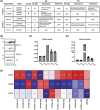Evaluation of Induced Pluripotent Stem Cell-Derived Dopaminergic Neurons from Siblings with Gaucher Disease Discordant for Parkinsonism
- PMID: 40568761
- PMCID: PMC12371625
- DOI: 10.1002/mds.30273
Evaluation of Induced Pluripotent Stem Cell-Derived Dopaminergic Neurons from Siblings with Gaucher Disease Discordant for Parkinsonism
Abstract
Background: In Gaucher disease (GD), glucocerebrosidase (GCase) deficiency results from biallelic pathogenic GBA1 variants. While GBA1 variants are a major risk factor for Parkinson's disease (PD), most patients with GD never develop parkinsonism.
Objectives: To understand factors impacting PD penetrance in patients with GD by comparing induced pluripotent stem cell (iPSC)-derived dopaminergic neurons (DANs) from GD siblings discordant for PD.
Methods: iPSCs, reprogrammed from two different sibling pairs where both siblings had GD but only one developed PD, were differentiated into DANs. In one family, DAN enrichment was achieved via geneticin selection and proteomic evaluations were performed.
Results: GCase and lipid substrate levels were similar in GD and GD/PD DANs. After geneticin selection, proteomic analysis of the enriched DANs showed upregulation of molecular chaperones in the GD/PD line.
Conclusion: PD discordance in both sets of GD siblings did not correlate with GCase or lipid substrate levels in DANs, implicating the involvement of other modifiers. Published 2025. This article is a U.S. Government work and is in the public domain in the USA. Movement Disorders published by Wiley Periodicals LLC on behalf of International Parkinson and Movement Disorder Society.
Keywords: GBA1; Gaucher disease; Parkinson's disease; dopaminergic neuron differentiation; neurodegeneration.
Published 2025. This article is a U.S. Government work and is in the public domain in the USA. Movement Disorders published by Wiley Periodicals LLC on behalf of International Parkinson and Movement Disorder Society.
Figures


Update of
-
Comparative study of enriched dopaminergic neurons from siblings with Gaucher disease discordant for parkinsonism.bioRxiv [Preprint]. 2024 Feb 28:2024.02.25.581985. doi: 10.1101/2024.02.25.581985. bioRxiv. 2024. Update in: Mov Disord. 2025 Aug;40(8):1719-1724. doi: 10.1002/mds.30273. PMID: 38529501 Free PMC article. Updated. Preprint.
References
-
- Anheim M, Elbaz A, Lesage S, et al. Penetrance of Parkinson disease in glucocerebrosidase gene mutation carriers. Neurology 2012;78(6):417–420. - PubMed
-
- Cilia R, Tunesi S, Marotta G, et al. Survival and dementia in GBA‐associated Parkinson's disease: the mutation matters. Ann Neurol 2016;80(5):662–673. - PubMed
MeSH terms
Substances
Grants and funding
LinkOut - more resources
Full Text Sources
Medical
Research Materials
Miscellaneous

